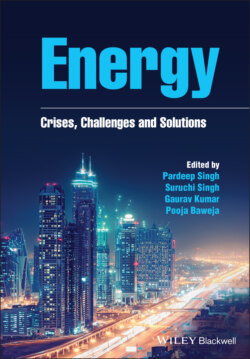Читать книгу Energy - Группа авторов - Страница 29
2.2 Need of Novel Research in Alternative Sources of Energy
ОглавлениеThe world population is expected to be around 9.8 billion by 2050 as projected by the UN's World Population Prospects 2019. This increase in population despite a continuous decline in birth rate globally demands a huge volume of energy resources to accomplish their daily requirements. If we look at the industrial needs of energy resources then also, we can understand the ever‐increasing demand due to intense industrialization in the past and will continue to rise in future as well. Reserves of coal, natural gas and crude oil which are available worldwide are predicted to be exhausted by 2300 if consumed at the same rate (Kougias et al. 2019). Geographical location of fossil fuels is not uniformly spread across the world. This uneven distribution of fossil fuels leads to high and unstable prices of petroleum‐based fuels. To accomplish the energy demand of the world population, use of renewable resources should also be increased consistently and in an exponential mode so that by 2300 the world can rely only on renewable resources. Further, usage of non‐renewable energy resources also increases the carbon emission. Total carbon emission from the consumption of energy resources is around 33,000 million metric tons in 2012 as reported by Global Status Report, 2014 (REN21, Paris 2014). This massive emission of CO2 leads to global warming and change in the earth atmosphere.
To maintain a balance between carbon emission and usage of energy resources, there is a need for such energy resources which have minimum or zero carbon emission. In the planetary emergency of climate change, there is a need for valuable lessons from the past. Remedy of this problem lies in the usage of renewable sources of energy which are in use from the past few decades but in small percentage. In order to decrease the dependency on fossil fuels, renewable energy sources consumption has to be promoted. At present, if one carefully looks at the various alternative sources of energy, namely solar, wind, biomass, hydropower, ocean and geothermal energy, then it can be realized that fossil fuels cannot be completely replaced by these energy sources. Alternative sources of energy are complementary to non‐renewable energy resources so this is the need of the hour to harness as much energy as possible via these sources. For the uniform and sustainable economic growth of a nation, use of renewable energy sources should be enhanced by the policymakers of a country (Bhattacharya et al. 2016). Also, some subsidies must be provided to the industry and end users to encourage the usage of alternative sources of energy. Recently, very promising research is performed in the process of harnessing energy through renewable energy sources in an efficient manner, explained in detail in the following sections of the chapter.
